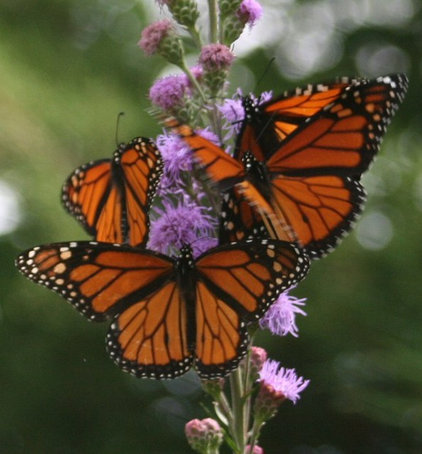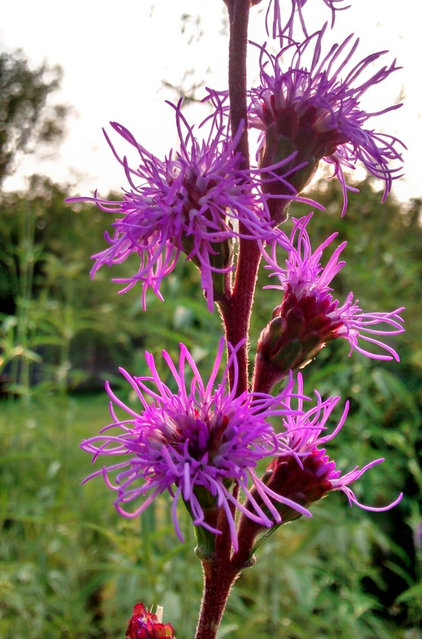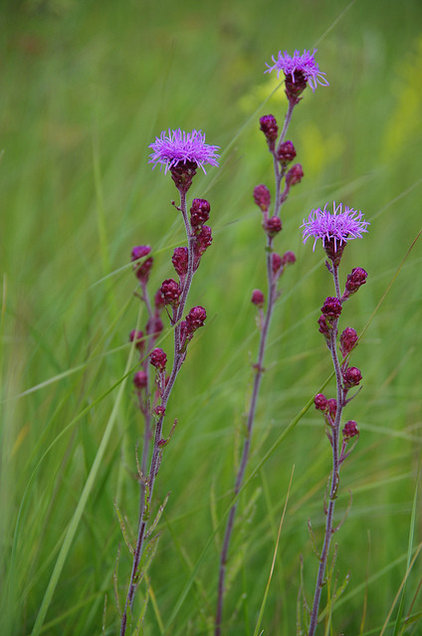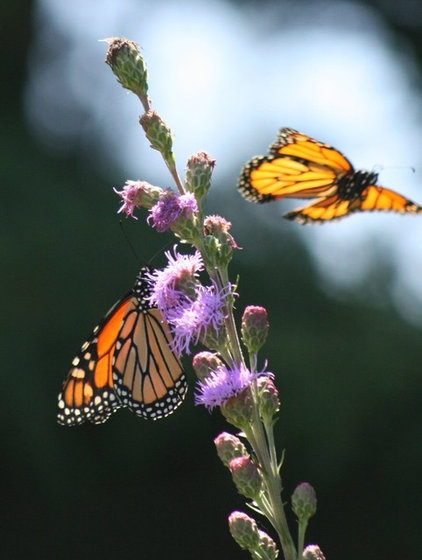I’d planted a liatris over there that I knew little about, since I was still in the beginning stages of experimenting with native plant placement. I rushed for my camera and witnessed something I never had before or have since — a dozen monarchs swooping and landing and literally fighting for every bloom on meadow blazingstar (Liatris ligulistylis). I’ve come to learn it is by far their favorite nectar source, and is a stunning plant in almost any soil condition.
 Benjamin Vogt / Monarch Gardens
Botanical name: Liatris ligulistylis
Benjamin Vogt / Monarch Gardens
Botanical name: Liatris ligulistylisCommon names: Meadow blazingstar, Rocky Mountain blazingstar
Origin: U.S. native in scattered spots in the Rocky Mountains and the Front Range, the northern Plains and the Midwest from Wisconsin, Illinois and Arkansas west.
Where it will grow: Hardy to -40 degrees Fahrenheit (USDA zones 3 to 7; find your zone); best planted if native to your area
Water requirement: Medium to wet soil
Light requirement: Full sun to 50 percent shade
Mature size: 3 to 5 feet tall and 1 foot wide
Benefits and tolerances: Very low maintenance; unique blooms, unlike other Liatris species; ornamental seed heads in fall; butterfly magnet
Seasonal interest: Fall color can be a rainbow assortment
When to plant: Spring to fall; seed in fall or winter
 Benjamin Vogt / Monarch Gardens
Distinguishing traits. Like all Liatris species, meadow blazingstar blooms from the top down. Its flower show will last about two weeks in mid to late summer; the blooms are perhaps most stunning backlit by a sunrise or sunset.
Benjamin Vogt / Monarch Gardens
Distinguishing traits. Like all Liatris species, meadow blazingstar blooms from the top down. Its flower show will last about two weeks in mid to late summer; the blooms are perhaps most stunning backlit by a sunrise or sunset.
 How to use it. With its small blueprint, you can tuck meadow blazingstar in almost anywhere. The tall flower spikes will add vertical interest in the middle of the border or especially among short grasses, like little bluestem (Schizachyrium scoparium) or sideoats grama (Bouteloua curtipendula). In a few years a single flower stalk will turn into several.
How to use it. With its small blueprint, you can tuck meadow blazingstar in almost anywhere. The tall flower spikes will add vertical interest in the middle of the border or especially among short grasses, like little bluestem (Schizachyrium scoparium) or sideoats grama (Bouteloua curtipendula). In a few years a single flower stalk will turn into several.Photo by Flickr user Marilena
 Benjamin Vogt / Monarch Gardens
Planting notes. I’ve found that this is a much more adaptable plant than many sources suggest. I have it growing in moist, medium and dry clay in full sun to 25 percent shade. It thrives in all of those locations.
Benjamin Vogt / Monarch Gardens
Planting notes. I’ve found that this is a much more adaptable plant than many sources suggest. I have it growing in moist, medium and dry clay in full sun to 25 percent shade. It thrives in all of those locations. I strongly suggest placing it by milkweed for a one-two punch — the Liatris will draw in monarchs (I usually don’t see any monarchs until it starts blooming in mid-July), which will then lay eggs on the milkweed, their only host plant. Asclepias incarnata and A. sullivantii are perfect companions to meadow blazingstar. Ready to make a monarch nirvana?
More:
Be a Butterfly Savior — Garden for the Monarchs
Browse plants native to your region
Call us at 378-5296 or click here and let us help put together a backyard that will really allow you to entertain this upcoming football season. The time to call in now, though. Gainesville Lawn projects typically take 4-6 weeks to plan, order materials, schedule, and then implement. With football season and fall kicking off just 3 weeks away, schedule your free consultation today.
